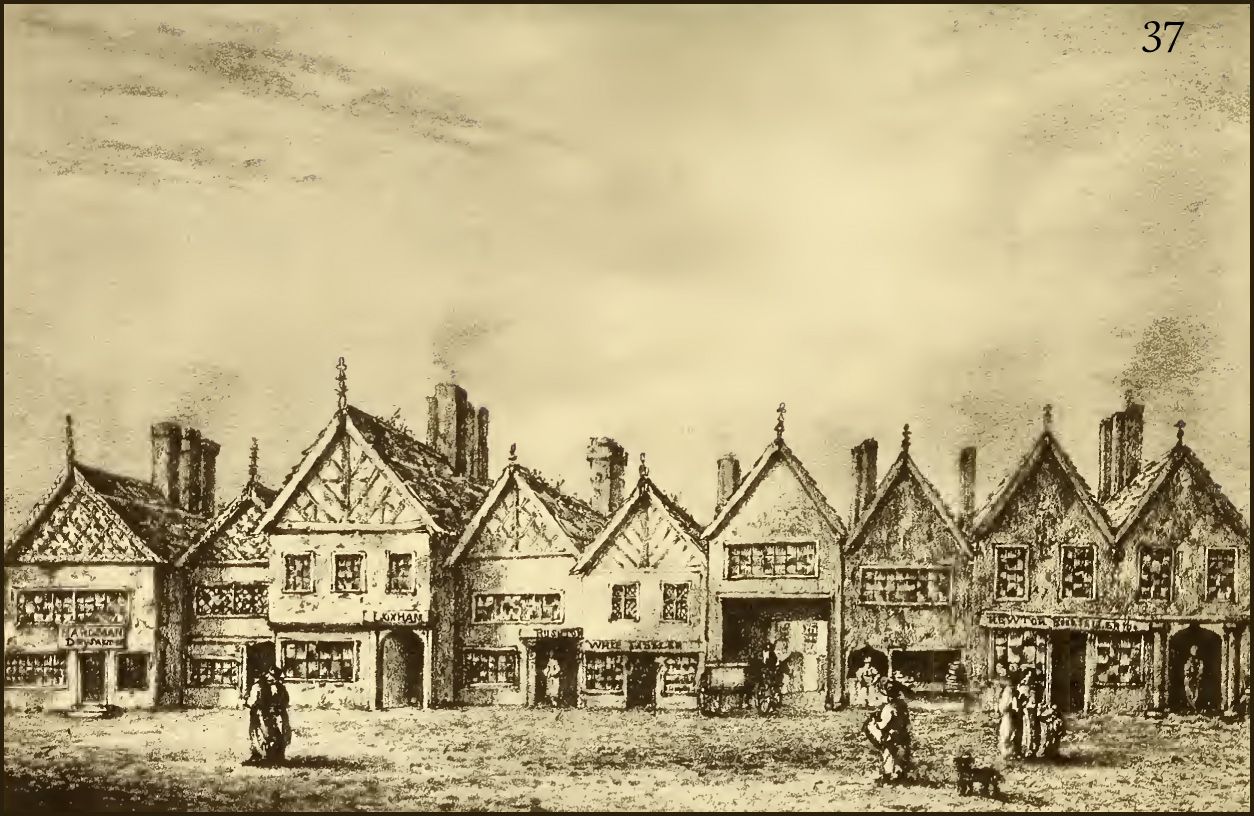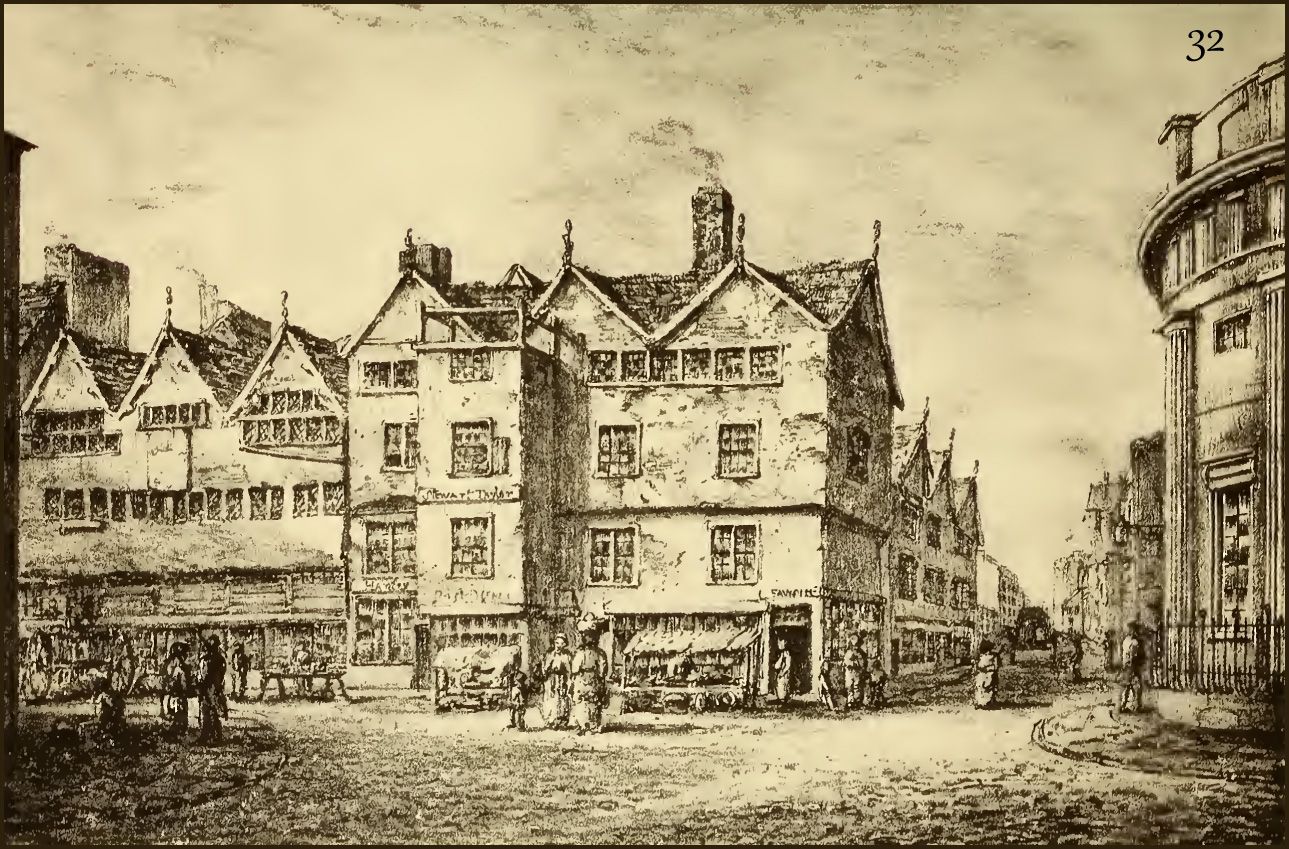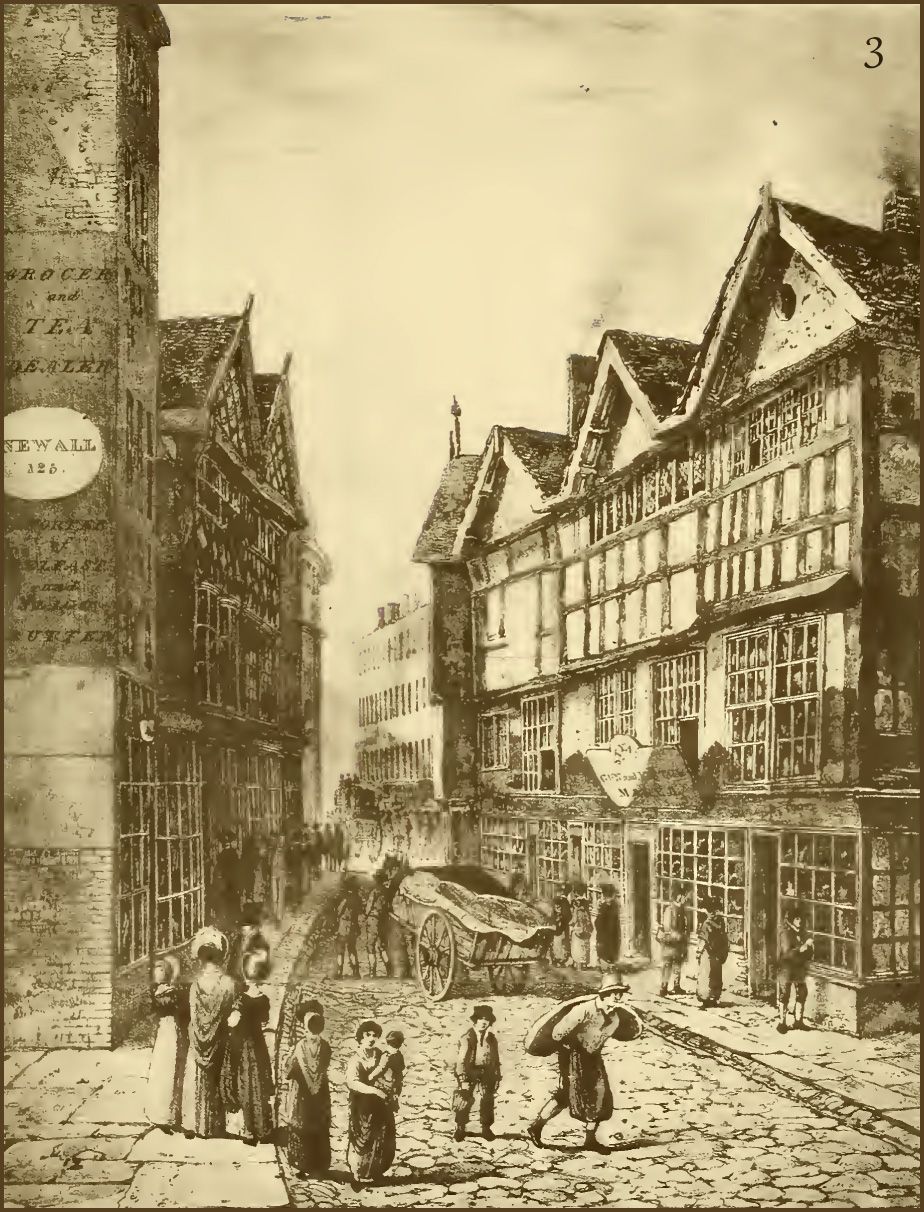
Page under construction
OLD MANCHESTER - A Series of Views ...
Drawn by Ralston, James, and Others
Introduction by James Croston, Pub 1875
map
market street
"FIFTY years have wrought a mighty change in the aspect of " Old Manchester,"— a change, greater perhaps than any other provincial town can show. In that period the hand of the improver has been busily employed, and comparatively little now remains to show how the commercial city of the present is linked with the small trading town of the past. Fifty years ago, though the place had increased in size as well as in wealth from the time when, a century previously, Dr. Stukeley, in his " Itinerarium Curiosum," described it as "the largest, most rich, populous and busy village in England," it still retained its ancient features, comparatively unimpaired. In the district immediately surrounding the Collegiate Church—the present Cathedral,—which then constituted the centre of the town, the streets were dingy, intricate, and ill -paved, and in many places so confined as to be perilous to the safety of the wayfarer. The houses bore the impress of antiquity, and scarcely a modern erection broke in upon the irregular line of buildings that had served as the dwelling-places of the Manchestrians for long generations previously. Quaint and picturesque were these memorials of former days; built, like so many of the houses in Lancashire and Cheshire, of wood and plaster, wrought in curious diaper-like patterns of black and white, with mullioned and latticed windows, overhanging roofs and gables, and grotesquely-carved hip-knobs, cornices, and pendants, presenting a marked contrast to the more stately, though not more ornate, erections with which the present generation is familiar.
Of these memorials of old Manchester scarcely a remnant has been preserved, the improvements that have been effected during the last half-century having swept away almost every trace. Though the veritable buildings have disappeared, the artist's skill has happily perpetuated the outlines, and made us
p.2
familiar with their general characteristics. About the year 1822 was published Jackson's "Views of Manchester Streets," comprising twelve illustrations from drawings by J. Ralston; this work was succeeded in 1825 by a series of thirtysix lithographic views by James ...
It is just a century since the first attempt to improve and widen the thoroughfares of Manchester was made. On the 2nd March, 1775, a meeting was held at that antiquated hostelry the Bull's Head, in the Market-place, at which a subscription was commenced for purchasing the buildings necessary for widening the old Mill-gate, St. Mary's-gate, and the passage leading from the Exchange to St. Ann's-square. Ten thousand pounds was the estimated sum required, and by the 25th July in the same year the secretary of the fund was able to announce that £10,771. 3s. 6d. had been contributed by sundry publicspirited individuals connected with the town. Some idea may be formed of the condition of these streets when it is remembered that Market-street, or Marketsted-lane * as it was then called, a narrow, tortuous thoroughfare, as the illustrations show, was thought to be a spacious street, and pronounced to be too wide to require any alteration.
* Sted or stead is here used in the old Anglo-Saxon sense of "place," as it is still retained in our words "home-stead," " farm-stead," &c.; the meaning being obviously Market-place lane, or the lane leading from the Market-place. The name is of frequent occurrence in the Court Leet records of the sixteenth century, where it is variously written Market-sted and Market-stid lane: it was subsequently corrupted into the anomalous appellation of Market-street-lane.
p3.
The building that gave name to Exchange-street, a view of which appears on the map of Manchester in 1772, was a somewhat heavy-looking structure of classic design, built in 1729 at the cost of Sir Oswald Mosley, then lord of the manor. It occupied the site of the old "Booths," on the opposite side of Market-street to the present Exchange, and served the threefold purpose of an Exchange, a butchers' market, and sessions and manorcourt-house; it was also used for theatrical performances before the old theatre was built on the site of the present Olivo's-buildings, at the corner of Brownstreet and Marsden-street.
Before the opening of Exchange-street in 1776, the only approach to St. Ann's square, then the fashionable quarter, was, for pedestrians, by a narrow gloomy passage called Acre's court, but more popularly known by the name of Dark Entry, that led beneath the Eagle and Child coffee-house, and across an open court in which stood a pump.

This coffee-house, with the picturesque group of gabled buildings adjoining it, is represented in No. 37 of James's views, and has been referred to by John Taylor, the Water-Poet, in his "Pennyless Pilgrimage."
I lodged at the Eagle and the Child,
Whereat my hostess (a good ancient woman)
Did entertain me with respect not common.
So Mistress Saracole*, hostess kind,
And Manchester with thanks I left behind.
The approach to the Square for vehicles was by a covered gateway, shown in the same view, at the further end of which was a cobbler's stall, with a staircase leading to the coffee-house ; and here also were the entrances to two other taverns, the Dog and the Goose.
* In the register of burials at the Collegiate Church the following entry occurs, under date 1628:— "Aprill 29. — Robarte Soracould, of Manchester, innkeeper," the husband, probably, of "Mistress Saracole"
p.4
After the completion of the improvements projected in 1775 no further alterations were attempted for several years, though complaints were frequently made of the narrowness of the streets, and the inconvenience caused by the crowding of them with carts and waggons, which were allowed to remain on market-days, few of the inns having yards attached to them; indeed, little effort seems to have been made to prevent encroachment or obstruction, for, if we may judge from the illustrations, the principal thoroughfare was made the general packing-place of the town.
Eventually, the doom of Market-sted-lane was pronounced. This street had long been inadequate to the convenient carrying on of the vast traffic with which it was continually crowded. To remedy the increasing evil, plans were prepared, and in 1821 an Act of Parliament was obtained to improve and widen it to the extent of twenty-one yards; and at the same time certain other approaches, avenues, and communications opening thereto, namely, the bottom of King-street, Hunter's-lane (the lower end of Cannon-street), Nicholas-croft, Toad-lane (Todd-street), and Toll-lane (the Deansgate end of St. Ann's street), were also widened ; the cost of the improvements being about, £200,000. The preamble to the Act sets forth that Market-street, "which is the principal thoroughfare of the town, is very narrow and inconvenient, and is in its present state dangerous for the persons and carriages passing through the same, and the trade and commerce of the said town have been much obstructed and injured, and various serious accidents have occurred, and many lives have been lost in consequence thereof."
It is difficult at the present day to realize what the appearance of this part of the town was before the alterations were made. Market-street was then only a narrow, tortuous lane, with tall, grimy buildings on each side, and so confined in places as hardly to allow space for two carts to pass, or a vehicle to turn round.

The first view in Ralston's series is taken from the lower end of Market street, and represents the Market-place as it appeared before the alterations; ... and a view from the same point is given in No. 32 of James's work. In this plate a busy yet homely scene meets the eye, the short contracted area with its confined approaches being crowded with stalls, on which are displayed almost every conceivable commodity, whilst carts, carriages, and wheelbarrows contend for space with a motley throng of hucksters and housewives, who seem entangled in inextricable confusion. The first building in the Market-place of which any record has been preserved was the "Booths," a timber structure, in which the town's Portmotes or Boroughreeve's Court and the Courts Leet and Baron of the feudal lords were held, and to which were subsequently added the Petty and Quarter Sessions. For centuries this was the only erection, and it was not unfrequently adorned with the heads of rebels and other criminals.

p. 5
To the "Booths" was added the old Exchange, which, as already stated, was taken down in 1792, the site being subsequently known by the name of Pennyless-hill, from the number of unemployed people who usually assembled there for hire; close by was the Cross, which, from the position marked on the plan of Manchester in 1650, occupied a portion of the site of the present fish-market, and contiguous were the pillory and the stocks, which were removed in 1812. Stalls and standings were no doubt erected from time to time, but the "Booths" appears to have been the only building in the Market-place until about the year 1475, when a shop was erected by one of the Traffords. "In the rentall of Thomas West, Lord de la Warr," says Hollingworth, "mencion is made of John Trafford, Knight, houlding one parcel of wast lying in Manchester, neere to the Booths, upon which onely one shop was then lately builded."
The building with the projecting staircase and railed terrace shown in our view was for many years the printing-office of Mr, Whitworth, and here an early local periodical, Whitworth's Manchester Gazette, had its birth December 22, 1730. The name was soon after changed to the Manchester Magazine, which continued to be published weekly for nearly twenty years. Mr. Whitworth was succeeded in his business by his son-in-law, Mr. Joseph Harrop, who established the Mercury March 3, 1752, a journal that outlived many competitors, and continued its weekly circulation until a short time before the building in which it originated was pulled down, when it became merged in the Manchester Guardian, the first number of which appeared Saturday, May 5, 1821. Mr. Harrop filled the office of Postmaster, and for a long series of years the postal business of the town was conducted on his premises. These, with the gabled building adjoining, occupied by Mr. Fawcett, silversmith, were taken down in order to widen the street, which at this point, as will be seen by the vista opening into Market street, was extremely narrow.
Market street, was extremely narrow. Of the Market-street of yore there are several illustrations : Ralston supplies six different lithographic views, in addition to the original sketches, and there are four plates in James's work. The first view No. 3 is taken from a point near the entrance to Cross-street, looking towards St. Mary's-gate. On the right is a group of half-timbered buildings, comprising four shops, with the signboard of Mr. Styan, a gun-maker, of some note in his day, placed conspicuously over the door of one. On the other side, in sharp perspective, we have the shop of Mr. Newall, a name that became famous in after-years, Newall's buildings, which he erected on the site, having been the home of the Anti- Cornlaw League.
NEXT PAGE
PREVIOUS PAGE